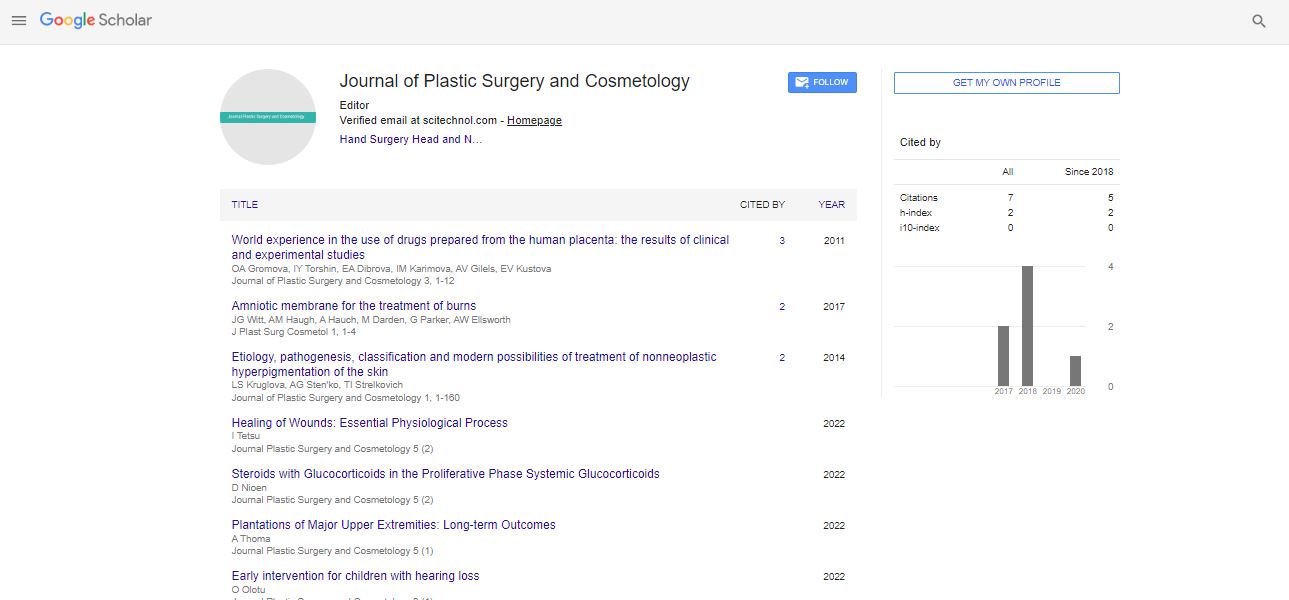Commentary, J Pls Sur Cos Vol: 4 Issue: 2
A Revolution in Surgery - Plastic Surgery
Joseph Wikki*
Department of Cosmetic Surgery, Korean Health University, Korea
*Corresponding Author: Joseph Wikki Department of Cosmetic Surgery, Korean Health University, Korea
Received: 03 December, 2021; Accepted: 17 December, 2021; Published: 24 December, 2021
Keywords: Cosmetology
Commentary
Plastic surgery is a surgical specialty involving the restoration, reconstruction, or revision of the mortal body. It can be divided into two main orders reconstructive surgery and ornamental surgery. Reconstructive surgery includes craniofacial surgery, hand surgery, microsurgery, and the treatment of becks. While reconstructive surgery aims to reconstruct a part of the body or ameliorate its functioning, dress (or aesthetic) surgery aims at perfecting the appearance of it.
The word plastic in plastic surgery means"reshaping"and comes from the Greek πλαστική (τέχνη), plastikē (tekhnē),"the art of modelling"of malleableflesh.This meaning in English is seen as early as 1598. The surgical description of "plastic" first appeared in 1839, antedating the ultramodern"engineering material made from petroleum" sense by 70 times.
Treatments for the plastic form of a broken nose are first mentioned in thec. 1600 BCE Egyptian medical textbook called the Edwin Smith papyrus. The early trauma surgery text was named after the American Egyptologist, Edwin Smith. Reconstructive surgery ways were being carried out in India by 800 BC. Sushruta was a croaker who made benefactions to the field of plastic and cataract surgery in the 6th century BC. Sushruta's developments were saved in his book, Sushruta Samhita.
The Roman scholar Aulus Cornelius Celsus recorded surgical ways, including plastic surgery, in the first century Announcement.
The Romans also performed plastic dress surgery, using simple ways, similar as repairing damaged cognizance, from around the 1st century BC. For religious reasons, they didn't anatomize either mortal beings or creatures, therefore their knowledge was grounded in its wholeness on the textbooks of their Greek forerunners. Notwithstanding, Aulus Cornelius Celsus left some unexpectedly accurate anatomical descriptions, some of which - for case, his studies on the genitalia and the shell - are of special interest to plastic surgery.
The Indian medical workshop of both Sushruta and Charaka, firstly in Sanskrit, were restated into the Arabic language during the Abbasid Caliphate in 750 Announcement. The Arabic restatements made their way into Europe via interposers. In Italy, the Branca family of Sicily and Gaspare Tagliacozzi (Bologna) came familiar with the ways of Sushruta.
Illustration of an 18th century nose reconstruction system from Poona performed by an Indian potter, Gentleman's Magazine 1794 British croakers traveled to India to see rhinoplasties being performed by Indian styles. (15) Reports on Indian rhinoplasty performed by a Kumhar vaidya were published in the Gentleman's Magazine by 1794. Joseph Constantine Carpue spent 20 times in India studying original plastic surgery styles. Carpue was suitable to perform the first major surgery in the Western world in the time of 1815. Instruments described in the Sushruta Samhita were further modified in the Western world
In 1465, Sabuncu's book, description, and bracket of hypospadias was more instructional and over to date. Localization of urethral meatus was described in detail. Sabuncuoglu also detailed the description and bracket of nebulous genitalia. ( citation demanded) Inmid-15th-century Europe, Heinrich von Pfolspeundt described a process"to make a new nose for one who lacks it entirely, and the tykes have devoured it"by removing skin from the reverse of the arm and stitching it in place. Still, because of the troubles associated with surgery in any form, especially that involving the head or face, it wasn't until the 19th and 20th centuries that similar surgery came common.
Acknowledgement
The authors are grateful to the journal editor and the anonymous reviewers for their helpful comments and suggestions.
Conflict of Interest
The authors declared no potential conflicts of interest for the research, authorship, and/or publication of this article.
 Spanish
Spanish  Chinese
Chinese  Russian
Russian  German
German  French
French  Japanese
Japanese  Portuguese
Portuguese  Hindi
Hindi 